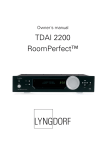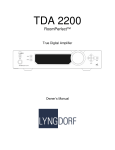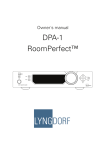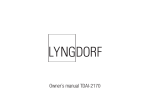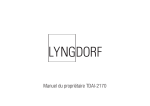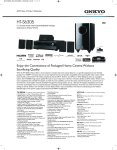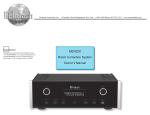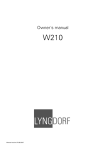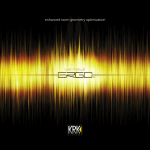Download Lyngdorf Audio RP-1 Speaker System User Manual
Transcript
Owner´s manual RP-1 RoomPerfect™ MENU ENTER RP-1 Room Processor 2 Table of Contents Operating Voltage 4 Input Connection 25 Unpacking the RP-1 4 Input Sensitivity 26 Serial Number Registration 4 Introduction 5 Accessories 6 Front Panel 7 Display Indicators 8 Rear Panel 8 Advanced Setup - Communication - Comm Address - Comm Speed - Line Out Level - Routing - Crossover Frequency - Filter Type - Delay - Remote Control - Firmware Versions - Factory Reset 26 26 26 26 27 27 28 28 29 29 30 30 Troubleshooting - RoomPerfect™ - RP-1 31 31 32 Firmware Upgrading 33 Connectors - Mains Connector - Balanced Inputs - Unbalanced Inputs 34 34 34 34 Cleaning and Maintenance 34 Technical Specifications - Audio - Protection - Mains - Mechanical 35 35 35 35 35 Technical Assistance 36 Appendix - Voicing Curves 37 37 Remote Control Connecting the RP-1 - Connecting to sources and amplifiers - Setup options of Main and Line outputs 10 12 12 14 Menu System - Navigating the Menu System 15 15 Menu Tree 16 Introduction to RoomPerfect™ - Global Listening - Focus Listening - Voicing 17 17 17 17 RoomPerfect™ - Guided Setup - Setting the Measurement Volume Level - Focus Measurement - Room Measurements - Adding more Room Measurements - Calculation of Focus and Global Filters - Advanced Options - Change Focus Pos. - Measure Room Pos. - RoomKnowledge - RoomCorrection 18 18 19 20 20 21 22 23 23 23 24 24 Display Display Timeout Display Brightness 25 25 25 Manual version 02-05-08 3 Operating Voltage The RP-1 can be switched between 115V and 230V mains voltage. In 115V mode the RP-1 requires a mains voltage of 100V-120V at 50-60Hz. In 230V mode the RP-1 requires a mains voltage of 220V-240V at 50-60Hz. The mains voltage setting for your RP-1 can be changed on the rear selector. Make sure the rear selector is in the correct position and connect the power input only to the appropiate AC source. The warranty will not cover any damage caused by connecting to the wrong type of AC mains. The RP-1 has three power modes: 1. OFF No circuitry is powered. Please note that some parts of the mains entry section still carry live mains. 2. STANDBY The microprocessor is active.. 3. ON All circuits active. Unpacking the RP-1 Carefully remove the unit and accessory kit from the carton, visually check for shipping damage. Contact both the shipper and your Lyngdorf Audio representative immediately if the unit bears any sign of damage from mishandeling. All Lyngdorf Audio equipment is carefully inspected before leaving our factory. Keep shipping carton and packing material for future use or in the unlikely event that the unit needs servicing. If this unit is shipped without the original packaging, damage could occur and void the warranty. Serial Number Registration Please record the serial number of your RP-1 here for future reference. The serial number is printed on the label on the rear panel. You will need this serial number, should you ever require service for your RP-1. RP-1 serial number: _____________________ 4 Introduction Congratulations on the purchase of your Lyngdorf Audio RP-1 with RoomPerfect™. This ‘Black Box’ expands your existing music system with the most advanced room correction system on the market. It is implemented in such a way that you will always achieve the perfect result. No computer needed, no acoustic knowledge needed, no user input needed. We leave nothing to chance in the fully automated calibration process. However, for the advanced user there are plenty of challenges since the RP-1 is also a complete ‘Control Centre’ that allows you to build advanced multi-way passive or active speaker systems. This is possible due to the very powerful built-in DSP ‘engine’ which facilitates signal routing, creation of active crossovers, delay settings etc. In fact we believe the RP-1 to be a true ‘Black Box’ in the way that it sets new standards for what’s possible to improve sonically in a music system. 5 Accessories You should find the following accessories included: Mains cord 8 m (26.25 feet) XLR – XLR cable Microphone Programming cable 1 2 4 5 7 8 9 digital 0 info 3 RP-1 RoomPerfect™ menu analog AMP Owner´s manual 6 RCS CD channel TUNER volume ENTER MENU ENTER RP-1 Room Processor A/B random repeat Microphone stand with Mic clamp (delivered in a separate carton) Remote control Warnings CAUTION: RISK OF ELECTRICAL SHOCK. DO NOT OPEN. CAUTION: TO REDUCE THE RISK OF ELECTRICAL SHOCK, DO NOT REMOVE COVER. NO USER-SERVICEABLE PARTS INSIDE. REFER SERVICING TO QUALIFIED PERSONNEL. TO REDUCE RISK OF FIRE OR ELECTRIC SHOCK, DO NOT EXPOSE THIS APPLIANCE TO RAIN OR MOISTURE. Explanation of graphical symbols Exclamation symbol The exclamation point within an equilateral triangle is intended to alert the user to the presence of important operating and maintenance (servicing) instructions in the literature accompanying the product. Lightning symbol The lightning with arrowhead symbol within an equilateral triangle is intended to alert the user to the presence of uninsulated “Dangerous Voltage” within the products’ enclosure that may be of sufficient magnitude to constitute a risk of electrical shock to a person. Light bulb symbol The light bulb is intended to note the user of important information or a detailed explanation. Important safety instructions 1. Read these instructions carefully before installing or operating this apparatus. 2. Keep these instructions. 3. Heed all warnings. 4. Follow all instructions. 5. 6. 7. Do not use this apparatus near water. Clean only with a dry cloth. Do not block any ventilation openings. Install in accordance with the manufacturer’s instructions. 8. Do not install near any heat sources such as radiators, heat registers, stoves, or other apparatus that produce heat. 9. Do not defeat the safety purpose of the grounding-type plug. A grounding-type plug has two pins and a third grounding prong. The third prong is provided for your safety. If the provided plug does not fit into your outlet, consult an electrician for replacement of the obsolete outlet. 10. Protect the power cord from being walked on or pinched, particularly at plugs, convenience receptacles, and the point where they exit from the apparatus. Do not use this unit with a damaged cord or plug. 11. Only use attachments and accessories specified by the manufacturer. 12. Use only with cart, stand, bracket, or table specified by the manufacturer, or sold with the apparatus. When a cart is used, use caution when moving the cart/apparatus combination to avoid injury from tipping over. 13. Unplug this apparatus during lightning storms or when unused for long periods of time. 14. Connect only to the proper mains voltage. 15. The mains plug is used as a disconnect device and shall remain readily operable. 16. Do not connect any output from the amplifier to any other amplifier’s output or any other voltage source. 17. Do not expose this apparatus to dripping or splashing and ensure that no objects filled with liquids, such as vases, are placed on the apparatus. 18. To avoid electrical shock, make sure that no conductive part of the loudspeaker wiring is exposed while the amplifier is operating. Do not connect loudspeakers with uninsulated terminals to the amplifier. 19. Refer all servicing to qualified service personnel. Servicing is required when the apparatus has been damaged in any way, such as when the power-supply cord or plug are damaged, liquid has been spilled or objects have fallen into the apparatus, the apparatus has been exposed to rain or moisture, does not operate normally or has been dropped. Version 23-08-2007 Warnings 6 This manual Front Panel MENU ENTER RP-1 Room Processor 1 2 3 4 Controls The buttons/controls on the front panel of the RP-1 can all be operated with a direct press. 1. Mains Switch Powers the RP-1 on/off. 2. Display Display with all information on menu system and status. 3. Navigation Keys Pressing the Enter button for 3 seconds will set the RP-1 in stand-by mode and turns On the RP-1 from stand-by mode with a short press. In normal operation mode the Up/Down toggles between the Focus and Global filter and Bypass whereas the Left/Right toggles between neutral and the available voicings. In menu mode used for navigation in the menu system: Up/Down, Left/Right & Enter. Pressing and holding down the Up/Down, Right/Left keys, changes some selected values fast. 4. Menu Button Toggles Menu mode on/off and navigates one level back when in menu mode. 7 Display Indicators 1 2 3 1. Menu Alphanumeric Display (2*20 Characters). 2. Standby Indicator Power On is indicated with display showing all information on status. Standby mode is indicated with the Standby Indicator being lit only. 3. RoomPerfect Logo Is illuminated whena RoomPerfect filter is engaged. Rear Panel 1 3 2 4 5 6 7 8 1. Analog Output Double pairs of balanced/XLR Left/Right analog outputs (Main and Line out). The best performance is obtained by using the balanced output. Also, it is possible to mix balanced and unbalanced connections - i.e. to connect e.g. the main channel via the balanced output and the line channel via the unbalanced output. Never connect balanced and unbalanced Line or Main out at the same time. Only connect either balanced or unbalanced for each Main out, Line out. 2. 115V and 230V mains voltage switch. Switches between 115V and 230V mains input voltage. Make sure the rear selector is in the correct setting and connect the power input only to an appropiate AC source. The warranty will not cover any damage caused by connecting to a wrong type of AC mains. 8 3. Analog Input Balanced/XLR Left/Right Analog input. Never connect balanced and unbalanced Input at the same time. 4. Analog Input Unbalanced/RCA Left/Right Analog input. The default Input setting is “Balanced / XLR”. This can be changed to “Unbalanced / RCA” from the “Input Connection” menu. If the setting is not set correctly you may experience humming. 5. Analog Output Double pairs of unbalanced/RCA Left/Right analog outputs (Main and Line out). Never connect balanced and unbalanced Output at the same time. 6. Mic. In Mic. in for connection of RoomPerfect™ microphone. 7. RS232 Input/Aux RS232 communication connectors for communication with a PC for firmware update, remote control from other Lyngdorf equipment with broadcast commands or linked control between several other amplifiers or other suitable equipment with a remote start. • The ‘INPUT’ is used for connection to a PC, or as a control input from a Lyngdorf master amplifier. • The ‘AUX’ connection bypasses input from other master amplifiers to the next amplifier. 8. Mains Input 9 Remote Control The remote control is used to access the menu system as well as the buttons directly accessible on the front panel. To control the RP-1 the RCS (Room Correction System) key must be pressed. The functionality of the buttons when RCS is pressed are as follows: 1. Standby The standby button puts the RP-1 in stand-by mode. 1 2. Numerical Button 1 Select focus listening mode. 3 2 5 3. Numerical Buttons 2-8 No function 2 3 4 5 6 7 8 9 4 digital 0 info 7 6 8 9 menu analog AMP RCS CD 6. Numerical Button 0 Selects bypass listening mode (no room correction filter selected). 15 channel volume ENTER 18 19 A/B 7. Info To select a specific Voicing filter, press the ‘Info’ followed by numerical button 0-6 within 2 seconds. 8. Analog No function 9. Mute No function. 10. Menu Activates or de-activates the Menu system on the Main display. 11. AMP Selects the remote for operation with a Lyngdorf Amplifier/Pre-amp. 12. RCS Selects the remote for operation with a Lyngdorf Room Processor. 13. CD Selects the remote for operation with a Lyngdorf CD Player. 14. Tuner No function. 15. Channel -/+ No function. 10 TUNER 14 12 17 5. Digital No function 10 13 11 4. Numerical Button 9 Selects global listening mode. 1 random repeat 16 16. Volume Up/down No function. 17. Up / Down / Left / Right In normal operation mode the Up/Down toggles between Bypass, Focus and Global filter and the Left/ Right toggles between Neutral and the available voicings. In menu mode they are used for navigation in the menu system. Pressing and holding down the Up/ Down, Right/Left keys, changes some selected values fast. 18. Enter Turns the RP-1 On from stand-by mode and works as Enter in menu system. 19. No Function. 11 Connecting the RP-1 The photos used are only meant as visual aids to show the versatility of the RP-1, Lyngdorf Audio doesn’t necessarily carry all other products with the described specifications in the product assortment. Connecting to sources and amplifiers The RP-1 is very simple to hook up. There are three basic ways to connect the RP-1 to your system. 1. Connect all sources to your preamplifier and connect it to the RP-1 input. Then connect the RP-1 output signal to a poweramplifier. Source(s) DPA-1 Digital Pre-Amplifier Preamp RP-1 Poweramp 2. Connect a single audio source to the RP-1 input. Then connect the RP-1 output signal to your integrated- or preamplifier. Source RP-1 DPA-1 Digital Pre-Amplifier Integrated amplifier / Preamp 12 3. • • If your integrated amplifier or preamp has a ‘tape 2’ loop (sometimes called recording loop) or ‘Pre in/out’: Connect the output of the ‘tape 2’ loop / ‘Pre out’ to the input of the RP-1. Then connect the output of the RP-1 to the input of the ‘tape 2’ loop / ‘Pre in’. Using this configuration enables you to use multiple audio sources without switching source and/or cables, since the ‘tape 2’ loop ‘Pre in/out’ is always active and not depending on other used inputs and outputs. Source(s) DPA-1 Digital Pre-Amplifier Integrated amp / Preamp-poweramp RP-1 When using Option 2 or a ‘tape 2’ loop as described in Option 3, be aware that your amplifiers volume control is set at an appropriate level when making the RoomPerfect calibration. Please refer to the chapter “Setting the Measurement Volume Level” for further information. 13 Setup options of Main and Line outputs As described in “Routing” and “Crossover Frequency” there are many ways to utilize the Main and Line outputs. Here we have described the three most common set-up´s. Please note the products, outputs and crossover frequencies are chosen randomly in these descriptions. Combine them as you see fit. 1. Single-amp set-up with full range main speakers (no subwoofer). A poweramp is connected to Main Outputs Left and Right. No crossover is selected. Main Output Left No filter Speaker 2. Speakers Poweramp RP-1 Speaker Line Output Right Mono lowpass filter set at 80Hz Active subwoofer Poweramp Lyngdorf 2+2 setup. A poweramp is connected to Line Outputs Left and Right and the highpass crossover is set at 400Hz. Lyngdorf boundary woofers are connected to Main Outputs Left and Right, through a poweramp, and the lowpass crossover set at 400Hz. Line Output Left + Right Highpass filter set at 400Hz Speakers 14 Main Output Right No filter Poweramplifier and subwoofer set-up. A poweramp is connected to the Main Outputs Left and Right and the highpass crossover is set at 80Hz. The Subwoofer is connected to the Line Output and the lowpass crossover is set at 80Hz. Remember to bypass or set the subwoofer cut-off frequency to maximum. Main Output Left + Right Highpass filter set at 80Hz 3. RP-1 Poweramp RP-1 Main Output Left + Right Lowpass filter set at 400Hz Poweramp Boundary woofers Menu System The Main Display on the front panel of the RP-1 shows all functionality and current status of the RP-1. An overview of the menu tree can be seen in the ‘Menu Tree’ chapter. Navigating the Menu System Pressing the Menu button on the front panel or the remote enters the menu or steps back one level in the menu system. Use the left/right arrows keys to navigate the Menu system. To access a sub menu setting press the Enter button. To change a setting, use the Up/Down and/or Left/Right arrows and press Enter to accept the change, or Menu to exit without applying any changes. Pressing and holding down the Up/Down, Right/Left keys, changes some selected values fast. 15 Menu Tree This is an overview of the entire RP-1 menu structure. RP-1 Main Menu RoomPerfect Advanced setup Guided setup Advanced options Change Focus Pos Measure Room Pos RoomKnowledge RoomCorrection Display Communication Comm Address Comm Speed Line Out Level Routing Crossover freq Filter Type Display Timeout Delay Disp . Brightness Remote Control Input Connection Firmware Versions Input Sensitivity Factory Reset 16 Introduction to RoomPerfect™ Once the guided set-up has been successfully completed you have the option to listen to music through two listening settings; Focus and Global room correction filters. To toggle between the two filters and ‘Bypass’ you simply press the Up/Down buttons on the front panel or remote control.They can also be selected directly with the numerical buttons on the remote, 0 for bypass, 1 for Focus or 9 for Global. Global Listening The Global filter improves the sound quality across the whole room. When you are listening to music in a room but are not sat in any particular listening position, the global filter gives the best result. Focus Listening The Focus filter improves the sound quality at a listening position by exploiting the 3-dimensional acoustic properties gained through the room measurements. This makes the Focus filter the best solution for optimal sound quality at a specific listening position. Voicing When using RoomPerfect™ you will experience a much more precise and detailed sound reproduction – which could also be described as more analytical. The Voicing setting is an EQ filter that can be used to gently amplify or attenuate certain frequencies according to your personal preferences and/or to compensate if a given recording sounds too ‘bright’ or too ‘dark’. The standard voicing settings, and their numerical value on the remote control, are: • Neutral (0), Music 1 (1), Music 2 (2), Relaxed (3), Open (4), Open Air (5), Soft (6). The frequency curves of the different voicing settings can be viewed in the appendix. Neutral is a bypass setting. You can toggle between neutral and the available voicings by pressing the Left/Right buttons on the remote or front panel. The can also be selected directly by pressing “info” followed by the voicing number on the remote control. 17 RoomPerfect™ The sub menus accessible in the RoomPerfect™ menu are: RoomPerfect Guided setup Advanced options Advanced options is only available when Guided set-up has been performed. Guided Setup When you enter the RoomPerfect™ Main Menu for the first time, only the Guided setup is available. Press Enter to initiate the guided set-up. The main steps in the guided set-up procedure are: • Setting the measurement volume level • Taking one Focus (listening position) measurement • Taking at least three room position measurements • Finally, automatic calculation of Focus and Global filters If you wish to leave the guided set-up at any time during the set-up, simply press the ‘Menu’ button and the following message appears, ‘Exit without saving? No/Yes’. • Choose Yes to exit the guided set-up without saving any data or, • Choose No to cancel and continue with the guided set-up. 18 Setting the Measurement Volume Level When setting the measurement volume level, it is important that you always judge whether the calibration volume is too loud. The calibration volume should not be so loud that it causes: • uncomfortably loud sounds that are inconvenient to you or your environment, or • damage to your loudspeakers. When the message ‘Connect and place mic. in focus pos.’ appears, connect the microphone to the microphone input found on the back panel. Thereafter, place the microphone, using the microphone stand, in an appropriate focus/listening position. This location should be at your main listening position, typically more or less centered between the loudspeakers. Make sure that the height and the orientation of the microphone corresponds to your typical listening height and direction as illustrated and do not block the line of sight between the microphone and the loudspeakers. When the microphone has been correctly connected and placed in the focus position, you are ready to set the calibration volume. The calibration signal is a combination of the high and low frequency measuring signals and is only presented in your left loudspeaker. The measuring signals sound very artificial and disharmonic due to the fact that they are composed of pure tones at different frequencies. Press Enter to confirm and to commence the calibration process. If the RP-1 is connected before the volume control of your amplifier e.g. when using Option 2 or a ‘tape 2’ loop as described in Option 3 in the “Connecting the RP-1” chapter, be aware that the volume control of your amplifier is set at an appropriate level when making the RoomPerfect calibration. The volume control should be set at 0dB, which typically is in the “12 o´ clock” position. This setting must be used again if you wish to add additional RoomPerfect measurements later. The test signal will start and shortly thereafter the RP-1 will suggest an initial estimate of the desired maximum calibration volume, displayed as ‘Adjust level: XX up/down - Retry/Save Current’ Please raise or lower the volume by pressing the Up/Down buttons on the RP-1 front panel or remote control towards the desired number of steps shown on the display but ensure you avoid clipping, uncomfortably loud levels and damage to the loudspeakers. Continue choosing Retry for a re-estimation of the desired maximum calibration volume, until an appropriate calibration volume is reached. If you find the suggested calibration volume too loud simply turn down the volume to an appropriate level and choose Save current. 19 When the message ‘Calibration ok. Press Enter to continue’ is displayed, the calibration volume has successfully been set and saved. Focus Measurement When the calibration is OK, press Enter to start the measuring process and ‘Measuring Focus position …’ will be displayed. Each measurement comprises four steps: • A low and a high frequency measuring signal first in the left and then in the right channel. The length of each measurement depends on a combination of the measurement volume, set in the calibration process, and the background noise in your local environment. Typical measuring times for the low and high frequency measuring signals are 25 and 5 seconds, respectively. You can exit a commenced measurement by pressing the “Menu” button. Do not sit in the listening position during focus measurements. The measurement will stop prematurely if an error occurs during the measuring process. In this case, an error message is displayed. Press Enter to continue and ‘Retry focus measurement – press Enter’ is displayed. If the error needs correcting this should be done at this point (see RoomPerfect™ troubleshooting), thereafter press Enter to retry the measurement. The measurement procedure will start again. A measurement has ended successfully when the last measuring signal stops and the display shows a RoomKnowledge rating, as ‘RoomKnowledge XX% - Measurement ok’. Press Enter to continue. Room Measurements The number of room positions needed depends on the value of RoomKnowledge, if it is below 90% after the third measurement the guide automatically includes extra room measurements until a RoomKnowledge of 90% or more has been achieved. The remaining measurements are to be placed in random positions in the room with random orientations of the microphone. Choosing these random or arbitrary positions and orientations is easy. All you have to do is place the microphone at different positions in the room and with different orientations. It is important to perform well spaced measurements to get a covering image of the acoustical properties in the room, i.e. varying positions, heights and orientations of the microphone. 20 For an optimal room correction it is very important that the measurements are: 1. performed more than 1 meter (approx. 3 feet) away from the loudspeakers, 2. not performed behind the loudspeaker, and 3. that there is at least 50 cm/1.5 ft between each measurement. 2. Not behind loudspeaker 3. 50 cm 1. 1m When a random measuring position and microphone orientation has been chosen press Enter. The measuring process will start and the display will show ‘Measuring room position 1’. The measurement will stop prematurely if an error occurs during the measuring process. In this case, the error message ‘Retry room measurement – press Enter’ is displayed. Press Enter to continue. If it is an error that needs correcting, then correct the error (see RoomPerfect™ trouble-shooting) and proceed with the room position measurement by pressing Enter. The measurement has ended successfully when the last measuring signal stops and the display shows ‘RoomKnowledge XX% - Measurement ok’. This process is repeated at least three times and until the RoomKnowledge reaches 90%. Adding more Room Measurements If you have performed successful measurements and RoomKnowledge has reached 90%, the message ‘Add more room meas.? Yes/No’ is displayed. At this point, or any time later, you can decide whether the acquired room measurements are sufficient or you wish to add further room measurements to learn more about the room’s acoustical information. Adding more room measurements results in a higher RoomKnowledge, this in turn improves the room correction filters. • Choose Yes to add more room measurements. The room measuring process is now continued as described in the previous section. • Choose No when no additional measurements are required. The RP-1 will return to full scale output. The message ‘Save guided measurement - Yes/No’ will be displayed when exiting a successfully completed guided set-up. • Choose Yes to save the results of the guided set-up and calculate the focus and the global room correction filters. • Choose No if you wish to exit the guided set-up without calculating any room correction filters, without saving the performed measurement. 21 Calculation of Focus and Global Filters When RoomPerfect™ calculates the filters the display shows the following, ‘Calculating filters - Please wait’. The filter calculation process can be expected to take anywhere between 5 seconds and a minute depending on the specific task. When RoomPerfect™ has calculated the room correction filters, they are automatically saved. You have now successfully completed a guided set-up and the RoomPerfect™ Advanced Menu is now available. 22 Advanced Options This section describes the options in the advanced menu, which is available after Guided Setup has been completed. Here you can change the listening position and add more room measurements, check the RoomKnowledge of your current set-up, and check the RoomCorrection for the different filters. Advanced options Change Focus Pos Measure Room Pos RoomKnowledge RoomCorrection If the RP-1 is connected before the volume control of your amplifier e.g. when using Option 2 or a ‘tape 2’ loop as described in Option 3 in the “Connecting the RP-1” chapter, be aware that the volume control of your amplifier is set at the same level as when making the initial RoomPerfect calibration. If you do not remember this setting, you will need to perform a new guided setup. Change Focus Position. If you want to replace your current listening position (Focus filter), place the microphone correctly in the new listening position and the measurement process can commence as described in the ‘Guided Setup’ chapter. After a successful measurement the message ‘RoomKnowledge XX% - Measurement ok’ is displayed. Press Enter to continue. The message ‘Replace old focus measurement?’ will appear. • choose Yes to replace the measurement or, • choose No to exit without saving the current measurement. Measure Room Pos. It is always possible to add more room measurements, which can increase RoomKnowledge and thereby fine tune both room correction filters (Focus and Global). Press Enter to start a new room measurement. First the volume must be calibrated, as described in the ‘Guided Setup’ chapter. Then place the microphone in a random room position and the measurement can commence. The volume can be changed at any time between measurements to suit a particular measurement situation. After a successful room measurement the RoomKnowledge is re-calculated and displayed as ‘RoomKnowledge XX% - Measurement X ok’. Press Enter to continue. 23 ‘Add more room meas.? Yes/No’ will show in the display: • choose Yes to add another room measurement or, • choose No to stop adding more room measurements. If No is chosen the RP-1 is will return to full scale output. ‘Save room measurement(s)? Yes/No’ will hereafter be shown. • choose Yes to save the performed room measurement, • and No to exit without saving any of the performed measurements. Adding one or more room measurements leads to a re-calculation of both filters (i.e. Global and Focus filters) due to the fact that more of room’s acoustic properties have been learned, something that affects these filters. When adding room measurements, make sure the system volume is the same for all measurements. Whether adding more room measurements now or later. If you can´t remember the volume setting, we recommend to delete the filter and start over. RoomKnowledge The RoomKnowledge index is a parameter that tells how much of the room’s acoustical properties have been learned. A high RoomKnowledge ( 90%) means that most of the room’s acoustical properties have been learned. The more room measurements you add, the higher the RoomKnowledge will become. The more that the acoustical properties of the room are learned, the greater the accuracy of the room correction. RoomCorrection The RoomCorrection index is a measure of how much processing is being employed in the room correction filter. To some extent the RoomCorrection index reflects how audible the correction is. However, the same amount of processing can sound very different due to placement in frequency of the processing. For low values (below 10%) of the room correction index, only subtle correction is needed to the original sound in the room. With high room correction index values more extensive processing is employed. 24 Display The sub menus accessible in the Display menu are: Display Display Timeout Disp. Brightness Display Timeout Display Timeout Display Timeout Display Timeout set-up is used for enabling/disabling the 10 sec. display ’switch’off’ feature. If enabled the Main Display reading will switch off after 10 sec of inactivity from the front panel buttons or remote. Display Brightness Display Brightness Disp. Brightness Display Brightness is used to control the brightness of the display. The brightness can be set to 25%, 50%, 75% or 100%. Input Connection Input Connection The Input Connection can be set to: • Balanced / XLR or, • Unbalanced / RCA The default setting is Balanced / XLR. Remember to select the same input as physically connected. If the setting is not correct you may experience humming. 25 Input Sensitivity Input Sensitivity The Input Sensitivity setting enables you to match the line level output of your pre-amplifier to the input sensitivity of the Lyngdorf Audio RP-1. The normal settings are: • Select ‘High’ for input levels <= 2.2Vrms and the output/input levels of your pre- and power amplifier will match. • Select ‘Low’ for input levels > 2.2V RMS. • Select ‘High + Gain’ for input levels <=2.2Vrms and add an extra +6dB gain to increase the output level of your pre-amplifier to match your power amplifier. This setting is only to be used in special cases where the output level from your pre-amplifier is too low to obtain full output from your power amplifier. In ‘High’ and ‘Low’ sensitivity the RP-1 has unity (0dB) gain. Selecting the correct setting will prevent clipping/distortion and obtain full scale output from your pre-amplifier. Advanced Setup The sub menus accessible in the Advanced menu are: Advanced setup Communication Crossover freq Line Out Level Filter Type Firmware versions Routing Delay Factory Reset Remote Control Communication The sub menus accessible in the Communication menu are: Communication Comm Address Comm Speed Comm Address The Communication Address setting identifies the RP-1 to the PC interface or other Lyngdorf products. In master mode the Lyngdorf equipment is normally set for 1, and the addresses 2-99 can be used for pre-amplifiers etc., but nothing is restricted. Comm Speed The Communication Speed setting is the RS232 Link interface speed. The default setting is 57600 baud. With different PC’s and different lengths of cables the settings can be changed to 9600 or 115200 baud. If a multi-amplifier set-up is installed with Master/Slave communication, a faster response can be observed when using higher speeds. 26 Line Out Level Line Out Level This adjusts the overall output level in steps of -0.1 db, it can be attenuated to –40 dB in total. Routing Routing In Routing it is possible to apply different settings to the Main and Line outputs: Symbol Name Main output Line Output R L Highpass filter X X R L Lowpass filter X X R L L R Left and Right channel switching X - M Mono - X M Mono lowpass filter X A highpass and a lowpass filter can be applied to the Main and Line outputs when you want to connect an additional amplifier or subwoofer along with your main amplifier. A Mono setting is also available for the Line output, this is used when connecting a single subwoofer to the Line output. If no filter is selected the full frequency range will be directed to the Main and Line Out terminals. If a filter is selected the frequencies above or below the selected crossover frequency will be directed to the analog Main or Line Out terminals. When a highpass or lowpass filter has been chosen, the Crossover Frequency and Filter Type menus are enabled. 27 Crossover Frequency Crossover freq. Crossover Frequency is only available when Routing has been setup. The Crossover Frequency can be selected anywhere between 40 – 9999Hz. It is very difficult to give exact guidelines to setting a suitable crossover frequency, filter type and order since this depends on the exact drivers and configurations. Therefore, the following recommendations should be seen as a good starting point only. In general, the recommended crossover frequency between (sub)woofers and main speakers is between 200 - 400 Hz. By using a high crossover frequency, the rear wall quarter wavelength reflection is removed from the main speakers. If a Lyngdorf Audio boundary woofer is used in a 2+2 set-up, a crossover frequency of 400 is recommended due to the high bandwidth of the boundary woofer. For conventional active subwoofers with built in low pass filter the recommended crossover frequency is the upper low-pass frequency of the subwoofer. If at all possible, the low pass filter in the subwoofer should be bypassed. Due to the quarter wave reflection from the rear wall corresponding to the depth of the subwoofer cabinet we recommend an crossover point at approximately 200 Hz. You might experiment with turning the subwoofer so the driver faces the wall in a distance of 5 to 10 cm. This will increase the bandwidth of the subwoofer. However, due to the limited bandwidth (frequency response) of most conventional subwoofers you might find it necessary to choose a lower crossover frequency. When ‘building’ active speaker systems it is recommended to use the original crossover point(s) used by the manufacturer. Due to the short wavelengths of the mid/high frequencies it is essential that both crossover frequency, filter type and order as well as delay is set correctly. Therefore, creating filters for active speakers is an iterative process that requires several critical listening sessions in order to achieve seamless integration of the different speaker drivers. Filter Type Filter Type Filter Type is only available when Routing has been setup. It is possible to choose from two different Filter Types in this menu. LiRi: (Linkwitz Riley) 2, 4 or 8 order. Butw: (Butterworth) 1, 2 or 4 order. In a 2+2 set-up (main speakers + Lyngdorf Audio boundary woofers) we recommend using a fourth order Linkwitz Riley filter. In set-ups using conventional active subwoofers – again due to limited bandwidth – we recommend using a second order butterworth filter. In active speaker systems it is recommended starting with a fourth order Linkwitz Riley filter. 28 Delay Delay If you are using a set-up with two main loudspeakers located at an identical distance to the listening position you don’t need to set a delay. However, if the distance isn’t identical and/or you are using a subwoofer, or a Lyngdorf Audio 2+2 system, you need to set a delay in order to ensure that the sound from each loudspeaker reaches the listening position simultaneously. This must be done for main left (ML) and right (MR) and as well as line left (LL) and right (LR). To set the delay all you need do is to measure the distance from each loudspeaker to the listening position and enter these values in the menu. The necessary delays are then automatically calculated and applied to each channel. 1 centimeter = 0.3937 in The fault message ‘Values for delay exceed limits’ is displayed when the difference between the distance from the speakers closest to, and the speakers furthest from, the listening position is too big. The biggest difference allowed is 340 cm / 134 in. If the fault message appears, you can use the following solutions: (Can be used individually or together to achieve a valid set-up with respect to the delay lengths): • Shorten the distances between your Main and Line channel loudspeakers resulting in a more compact loudspeaker set-up. • Arrange your loudspeaker set-up and/or your listening position in a more symmetrical set-up. Remote Control Remote Control Remote Control set-up makes it possible to activate or de-activate the remote control. 29 Firmware Versions Firmware versions The Firmware Versions menu is used to check the current firmware version of your RP-1 and the RoomPerfect™ module as well as the RoomPerfect™ serial number. Factory Reset Factory Reset The Factory Reset setting is used to restore all settings, including RoomPerfect, in the RP-1 to the factory settings. If you return to the factory settings all your personal settings will be erased. 30 Troubleshooting RoomPerfect™ No microphone connected The error message ‘No microphone connected’ is displayed when no microphone is connected to the RP-1. Solution: • Connect the microphone on the back panel. No signal 1. The error message ‘Fault – No signal’ is displayed when the incoming signal is classified as pure noise. This happens when the RP-1´s measuring signal is too low compared with the noise from the local environment. 2. The volume setting of your amplifier and/or RP-1 measuring volume is to low. 3. The above error message is also displayed when the loudspeakers are not connected. Solution: • Reduce the noise in your measuring environment. • Raise the volume setting of your amplifier and/or RP-1 measuring volume before continuing with the measurement. • Connect your loudspeakers. Low signal The error message ‘Fault – Low signal’ is displayed when the measurement has taken more than 5 minutes for the low frequency signal or 2 minutes for the high frequency signal. This happens when the system calibration volume is low compared to the background noise of your environment, something that results in prolonged measuring times. Solution: • Raise the RP-1´s measuring volume or the volume setting of your amplifier before continuing with the measurement, or reduce the noisy elements in your environment. Signal clipping 1. The error message ‘Fault – Signal clipping’ is displayed when the incoming signal is classified as too loud resulting in clipping (distortion). 2. A loud noise from the local environment that has corrupted the measurement results in this error message. Solution: • Lower the measuring signal volume before continuing with the measurement. • Repeat the measurement with no changes; however refrain from making excessive noise when measuring. 31 Troubleshooting RP-1 Speakers are humming when the RP-1 is turned on Balanced and unbalanced for Main out connections are used at the same time. Solution: • Disconnect the interfering connection. Speakers are humming when the RP-1 is turned on Balanced and unbalanced for Line out connections are used at the same time. Solution: • Disconnect the interfering connection. Speakers are humming when the RP-1 is turned on Balanced and unbalanced for Input connections are used at the same time. Solution: • Disconnect the interfering connection, and remember select the correct setting in the ‘input connection’ menu. 32 Firmware Upgrading The RP-1 firmware can be upgraded using the ‘Lyngdorf Audio – Serial Load’ software. This is in the PC package available from www.Lyngdorf.com. Press the Enter button while powering On to bring the product into upgrade mode. 33 Connectors Mains Connector Mains voltage to the RP-1 is applied via an IEC320 type connector. The supplied cable with safety ground should be used to connect the RP-1 to a mains outlet. Make sure the rear selector is in the correct setting and connect the power input only to an appropiate AC source. The warranty will not cover any damage caused by connecting to the wrong type of AC mains. Always disconnect the RP-1 from the mains before changing any connections to its inputs or outputs. Balanced Inputs The balanced XLR inputs are wired in accordance with IEC268: Pin 1: Chassis and ground. Pin 2: Hot (+). Pin 3: Cold (-). Shell: Chassis and ground. Unbalanced Inputs The unbalanced RCA inputs are wired in accordance with normal practice: Shell: Chassis and ground. Pin: Hot (+). Cleaning and Maintenance This unit does not require any regular maintenance except to keep its exterior clean. Simply wipe its exterior with a clean soft cloth. A small amount of non-abrasive cleaner may be used on the cloth to remove any excessive dirt or fingerprints. Do not use abrasive cleaners or cleaners containing liquid solvents. 34 Technical Specifications Audio Parameter Value Note Balanced input connectors 3 pin XLR, gold-plated. Case=Gnd, Pin1=Gnd, Pin2=Hot(+), Pin3=Cold(-) Balanced input impedance 10KOhm AC-coupled. Unbalanced input connectors RCA (phono) jack, gold-plated. Case=Gnd, Tip=Hot(+) Unbalanced input impedance 10KOhm AC-coupled Input sensitivity 4.4V (2.2V with high sens.) DAC Out impedance 50Ohm Unbalanced output Unity 0dB according to input level Balanced output Unity 0dB according to input level Frequency Response 20 - 20KHz +/-0.1dB RoomPerfect Highpass Filter -3dB at 18Hz THD+N A-wgt Analog to Analog -103dB Neutral voicing - ref 4.4V S/N Ratio Analog to Analog 113dB Neutral voicing - ref 4.4V Dynamic Range Analog to Analog 113dB Neutral voicing - ref 4.4V Channel Separation 114dB AC Sweep from 125 - 16KHz All audio measurements, except frequency response, are measured with a 20KHz low-pass filter in accordance with AES-17. Protection Parameter Value Value Grounding Mains earth, chassis and audio ground are connected internally. Over temperature Mains-transformer. Auto resetting thermal fuse in mains transformer. Parameter Value Note Mains input connector IEC 320 cold type Mains lead supplied. Mains voltage range 100-240V AC, 50–60Hz Power consumption 4W STANDBY mode. 230V AC. Power consumption 23 W OPERATE mode. 230V AC. Parameter Value Note Width 450mm (17.72”) Depth 355mm (13.98”) Height 100mm (3.94”) Net weight 6.6 Kg (14.6 lb.) Shipping weight 9.9 Kg (21.8 lb.) Mains Mechanical Including feet. 2 shipping boxes 35 Technical Assistance For latest version of the firmware, the newest version of this document and ‘Questions and Answers’, please check the ‘Support’ section on the Lyngdorf Audio website. If you have any problems with or questions regarding your Lyngdorf Audio product, please contact your nearest Lyngdorf Audio representative or: Lyngdorf Audio ApS Denmark E-mail: [email protected] Web: http://www.lyngdorf.com 36 Appendix Voicing Curves Music 1 Music 2 Ma gnitude R esponse: Music 1 Ma gnitude R esponse: Music 2 6 6 4 4 2 2 Magnitude (dB ) Magnitude (dB ) For further information on the Voicing setting, please refer to the “Voicing” chapter. 0 -2 0 -2 -4 -4 -6 -6 10 Hz 100 Hz 1kHz 10kHz 10 Hz 100 Hz F requency (Hz) Relaxed Ma gnitude R esponse: Open 6 6 4 4 2 2 Magnitude (dB ) Magnitude (dB ) 10kHz Open Ma gnitude R esponse: R ela x ed 0 -2 -4 0 -2 -4 -6 -6 10 Hz 100 Hz 1kHz 10 Hz 10kHz 100 Hz 1kHz 10kHz F requency (Hz) F requency (Hz) Soft Open Air Ma gnitude R esponse: S oft Ma gnitude R esponse: Open Air 6 6 4 4 2 2 Magnitude (dB ) Magnitude (dB ) 1kHz F requency (Hz) 0 -2 -4 0 -2 -4 -6 -6 10 Hz 100 Hz 1kHz F requency (Hz) 10kHz 10 Hz 100 Hz 1kHz 10kHz F requency (Hz) 37 38 39 www.lyngdorf.com 40








































